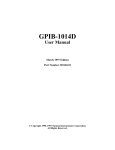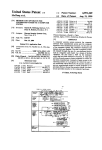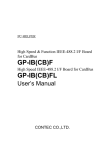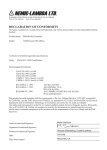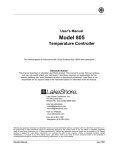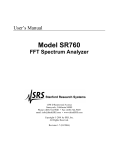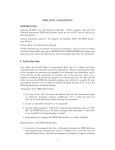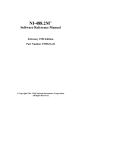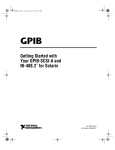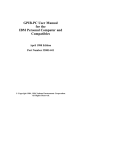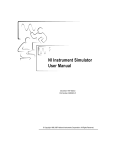Download ESP-488 Software Reference Manual for VxWorks and the GPIB
Transcript
ESP-488 Software Reference
Manual for VxWorks and
the GPIB-1014/1014D
National Instruments IEEE-488 Engineering Software Package
for the VxWorks Operating System
March 1994 Edition
Part Number 320429-01
© Copyright 1991, 1994 National Instruments Corporation.
All Rights Reserved.
National Instruments Corporate Headquarters
6504 Bridge Point Parkway
Austin, TX 78730-5039
(512) 794-0100
Technical support fax: (512) 794-5678
Branch Offices:
Australia 03 879 9422, Austria 0662 435986, Belgium 02 757 00 20, Canada (Ontario) 519 622 9310,
Canada (Québec) 514 694 8521, Denmark 45 76 26 00, Finland 90 527 2321, France 1 48 65 33 70,
Germany 089 714 50 93, Italy 02 48301892, Japan 03 3788 1921, Netherlands 01720 45761, Norway 03 846866,
Spain 91 640 0085, Sweden 08 730 49 70, Switzerland 056 27 00 20, U.K. 0635 523545
Limited Warranty
The media on which you receive National Instruments software are warranted not to fail to execute programming
instructions, due to defects in materials and workmanship, for a period of 90 days from date of shipment, as
evidenced by receipts or other documentation. National Instruments will, at its option, repair or replace software
media that do not execute programming instructions if National Instruments receives notice of such defects during
the warranty period. National Instruments does not warrant that the operation of the software shall be uninterrupted
or error free.
A Return Material Authorization (RMA) number must be obtained from the factory and clearly marked on the
outside of the package before any equipment will be accepted for warranty work. National Instruments will pay the
shipping costs of returning to the owner parts which are covered by warranty.
National Instruments believes that the information in this manual is accurate. The document has been carefully
reviewed for technical accuracy. In the event that technical or typographical errors exist, National Instruments
reserves the right to make changes to subsequent editions of this document without prior notice to holders of this
edition. The reader should consult National Instruments if errors are suspected. In no event shall National
Instruments be liable for any damages arising out of or related to this document or the information contained in it.
EXCEPT AS SPECIFIED HEREIN, NATIONAL INSTRUMENTS MAKES NO WARRANTIES, EXPRESS OR IMPLIED,
AND SPECIFICALLY DISCLAIMS ANY WARRANTY OF MERCHANTABILITY OR FITNESS FOR A PARTICULAR
PURPOSE. CUSTOMER'S RIGHT TO RECOVER DAMAGES CAUSED BY FAULT OR NEGLIGENCE ON THE PART
OF NATIONAL INSTRUMENTS SHALL BE LIMITED TO THE AMOUNT THERETOFORE PAID BY THE CUSTOMER.
NATIONAL INSTRUMENTS WILL NOT BE LIABLE FOR DAMAGES RESULTING FROM LOSS OF DATA, PROFITS,
USE OF PRODUCTS, OR INCIDENTAL OR CONSEQUENTIAL DAMAGES , EVEN IF ADVISED OF THE POSSIBILITY
THEREOF. This limitation of the liability of National Instruments will apply regardless of the form of action,
whether in contract or tort, including negligence. Any action against National Instruments must be brought within
one year after the cause of action accrues. National Instruments shall not be liable for any delay in performance due
to causes beyond its reasonable control. The warranty provided herein does not cover damages, defects,
malfunctions, or service failures caused by owner's failure to follow the National Instruments installation, operation,
or maintenance instructions; owner's modification of the product; owner's abuse, misuse, or negligent acts; and
power failure or surges, fire, flood, accident, actions of third parties, or other events outside reasonable control.
Copyright
Under the copyright laws, this publication may not be reproduced or transmitted in any form, electronic or
mechanical, including photocopying, recording, storing in an information retrieval system, or translating, in whole
or in part, without the prior written consent of National Instruments Corporation.
Trademarks
NI-488® is a trademark of National Instruments Corporation.
Product and company names listed are trademarks or trade names of their respective companies.
Warning Regarding Medical and Clinical Use
of National Instruments Products
National Instruments products are not designed with components and testing intended to ensure a level of reliability
suitable for use in treatment and diagnosis of humans. Applications of National Instruments products involving
medical or clinical treatment can create a potential for accidental injury caused by product failure, or by errors on
the part of the user or application designer. Any use or application of National Instruments products for or involving
medical or clinical treatment must be performed by properly trained and qualified medical personnel, and all
traditional medical safeguards, equipment, and procedures that are appropriate in the particular situation to prevent
serious injury or death should always continue to be used when National Instruments products are being used.
National Instruments products are NOT intended to be a substitute for any form of established process, procedure, or
equipment used to monitor or safeguard human health and safety in medical or clinical treatment.
Contents
About This Manual ............................................................................................................ix
Organization of This Manual .........................................................................................ix
Conventions Used in This Manual.................................................................................x
Abbreviations.....................................................................................................x
Related Documentation..................................................................................................x
Customer Communication .............................................................................................x
Chapter 1
Introduction ..........................................................................................................................1-1
What Your Kit Should Contain......................................................................................1-1
Important Considerations...............................................................................................1-1
Chapter 2
The C Language Library .................................................................................................2-1
Global Variables ............................................................................................................2-1
Status Word – ibsta ............................................................................................2-1
Error Variable – iberr.........................................................................................2-2
Count Variable – ibcnt .......................................................................................2-3
Read and Write Termination..........................................................................................2-4
Compiling C Programs...................................................................................................2-4
GPIB Function Descriptions ..........................................................................................2-5
Device-Level Functions .................................................................................................2-5
Low-Level Functions .....................................................................................................2-5
Chapter 3
ibic ............................................................................................................................................3-1
Running ibic...................................................................................................................3-1
Syntax Translation Guidelines.......................................................................................3-1
Sample Session ..............................................................................................................3-2
Auxiliary Functions........................................................................................................3-3
Chapter 4
ESP-488 Functions and Utilities Reference ...............................................................4-1
IBIC(1)...........................................................................................................................4-2
IBTEST(1) .....................................................................................................................4-6
DVCLR(3) .....................................................................................................................4-7
DVRD(3)........................................................................................................................4-8
DVRSP(3) ......................................................................................................................4-10
DVTRG(3) .....................................................................................................................4-12
DVWRT(3) ....................................................................................................................4-13
IBCAC(3).......................................................................................................................4-15
IBCMD(3)......................................................................................................................4-16
IBEOS(3) .......................................................................................................................4-18
© National Instruments Corporation
v
ESP-488 for VxWorks and GPIB-1014/1014D
Contents
IBEOT(3) .......................................................................................................................4-20
IBGTS(3) .......................................................................................................................4-21
IBLINES(3)....................................................................................................................4-22
IBONL(3).......................................................................................................................4-23
IBPAD(3).......................................................................................................................4-24
IBRD(3) .........................................................................................................................4-25
IBRPP(3)........................................................................................................................4-27
IBRSV(3) .......................................................................................................................4-28
IBSAD(3).......................................................................................................................4-29
IBSIC(3).........................................................................................................................4-30
IBSRE(3)........................................................................................................................4-31
IBTMO(3) ......................................................................................................................4-32
IBWAIT(3).....................................................................................................................4-34
IBWRT(3) ......................................................................................................................4-36
Appendix A
Multiline Interface Command Messages ....................................................................A-1
Appendix B
GPIB-1014/1014D Configuration and Installation .................................................B-1
GPIB-1014 Hardware Configuration.............................................................................B-1
GPIB-1014D Hardware Configuration ..........................................................................B-2
GPIB-1014/1014D Hardware Installation .....................................................................B-3
Software Installation and Configuration........................................................................B-3
Changing the Configuration...............................................................................B-4
Installing Multiple Driver Modules ...................................................................B-5
Appendix C
GPIB Programming Example ........................................................................................C-1
Appendix D
Customer Communication...............................................................................................D-1
ESP-488 for VxWorks and GPIB-1014/1014D
vi
© National Instruments Corporation
Contents
Tables
Table 2-1.
Table 2-2.
Status Word Layout ..........................................................................................2-1
GPIB Error Codes.............................................................................................2-2
Table 3-1.
Auxiliary Functions that ibic Supports.............................................................3-3
Table
Table
Table
Table
Table
Table
Table
4-1.
4-2.
4-3.
4-4.
4-5.
4-6.
4-7.
Syntax of ESP-488 Functions in ibic................................................................4-2
Status Word Layout ..........................................................................................4-4
GPIB Error Codes.............................................................................................4-4
Auxiliary Functions that ibic Supports.............................................................4-5
Data Transfer Termination Method..................................................................4-18
Timeout Settings...............................................................................................4-32
Wait Mask Layout ............................................................................................4-34
Table
Table
Table
Table
B-1.
B-2.
B-3.
B-4.
GPIB-1014 Hardware Configuration Settings..................................................B-1
GPIB-1014D Hardware Configuration Settings...............................................B-2
Software Distribution Files...............................................................................B-4
Naming Syntax for esp488_2.o ........................................................................B-5
© National Instruments Corporation
vii
ESP-488 for VxWorks and GPIB-1014/1014D
About This Manual
This manual describes the IEEE-488 Engineering Software Package (ESP-488) for the VxWorks
operating system (Version 5.0 and higher) from Wind River Systems, Inc. This package is
intended to be used with one of the following interface boards:
•
•
National Instruments GPIB-1014
National Instruments GPIB-1014D
Organization of This Manual
This manual is organized as follows:
Chapter 1, Introduction, contains an overview of the ESP-488 VxWorks software, lists the
contents of the ESP-488 VxWorks kit, and describes important considerations for using the
software.
Chapter 2, The C Language Library, contains a general description of the C language
programming interface to the ESP-488 VxWorks device driver, including the GPIB device-level
and low-level functions.
Chapter 3, ibic, introduces you to the Interface Bus Interactive Control (ibic) program. This
chapter also contains instructions for running ibic, contains guidelines for translating ibic
syntax, contains a sample session, and summarizes the auxiliary functions that ibic supports.
Chapter 4, ESP-488 Functions and Utilities Reference, contains detailed information for using
the functions and utilities contained in the ESP-488 software package. For ease of use, this
material is presented in a format familiar to most users of the UNIX and VxWorks operating
systems.
Appendix A, Multiline Interface Command Messages, is a listing of multiline interface
messages.
Appendix B, GPIB-1014/1014D Configuration and Installation, describes how to configure and
install the hardware and software for the GPIB-1014 and GPIB-1014D interface boards.
Appendix C, GPIB Programming Example, illustrates the steps involved in programming a
representative IEEE-488 instrument from a terminal using the ESP-488 functions in C language.
This appendix is designed to help you learn how to use the ESP-488 driver software to execute
certain programming and control sequences.
Appendix D, Customer Communication, contains forms you can use to request help from
National Instruments or to comment on our products and manuals.
© National Instruments Corporation
ix
ESP-488 for VxWorks and GPIB-1014/1014D
About This Manual
Conventions Used in This Manual
The following conventions are used to distinguish elements of text throughout this manual:
italic
Italic text denotes emphasis, a cross reference, or an introduction to a key
concept.
monospace
Text in this font denotes text or characters that are to be literally input
from the keyboard, sections of code, programming examples, and syntax
examples. This font is also used for the proper names of disk drives,
paths, directories, programs, subprograms, subroutines, device names,
functions, variables, filenames and extensions, and for statements and
comments taken from program code.
bold italic
Bold Italic text denotes an important note.
Abbreviations
The following abbreviations for units of measure are used in this manual:
µsec
msec
sec
microsecond
millisecond
second
Related Documentation
The following documents contain information that you may find helpful as you read this manual:
•
ANSI/IEEE Standard 488-1987, IEEE Standard Digital Interface for Programmable
Instrumentation
•
GPIB-1014 User Manual (part number 320030-01)
•
GPIB-1014D User Manual (part number 320140-01)
Customer Communication
National Instruments wants to receive your comments on our products and manuals. We are
interested in the applications you develop with our products, and we want to help if you have
problems with them. To make it easy for you to contact us, this manual contains comment and
configuration forms for you to complete. These forms are in Appendix D, Customer
Communication, at the back of this manual.
ESP-488 for VxWorks and GPIB-1014/1014D
x
© National Instruments Corporation
Chapter 1
Introduction
This chapter contains an overview of the ESP-488 VxWorks software, lists the contents of the
ESP-488 VxWorks kit, and describes important considerations for using the software.
ESP-488 is a functional subset of the industry standard NI-488 GPIB driver software. Standard
ESP-488 implements an optimized set of ten fundamental GPIB functions for low-level
communication and control through a single GPIB interface. In addition to this core set of ten
functions, ESP-488 for VxWorks includes several functions for interface configuration and highlevel device communication. Other features include timeout support, error reporting, and an
interactive control utility (ibic) similar to the ibic included with NI-488 software packages.
What Your Kit Should Contain
Your kit should contain the following components:
Component
Part Number
One of the following software media:
•
•
UNIX tar formatted streaming tape for
the ESP-488 VxWorks software
460861-13
UNIX tar formatted 9-track tape for
the ESP-488 VxWorks software
430861-13
ESP-488 for VxWorks and the GPIB-1014/1014D
Software Reference Manual
320429-01
Important Considerations
Before using the ESP-488 VxWorks software, you must install an appropriate GPIB interface
board and load the software from tape. Refer to Appendix B, GPIB-1014/1014D Configuration
and Installation, for instructions on installing the hardware and software.
Consider also the following points when using the ESP-488 software:
•
The ESP-488 functions support synchronous I/O transfers through a single GPIB interface.
The functions are intended to be accessed by only one program task at a time.
© National Instruments Corporation
1-1
ESP-488 for VxWorks and GPIB-1014/1014D
Introduction
Chapter 1
•
All functions return a subset of the standard NI-488 status bit vector as described later in this
manual. The result of the last call is also available in the global variable, ibsta. Additional
information on the result of the last call is sometimes contained in the global variables
ibcnt and iberr. Refer to Chapter 2, The C Language Library, for more information on
the global variables.
•
The GPIB interface is normally designated to be the System Controller. Most ESP-488
functions are optimized to assume the GPIB interface is also the Controller-In-Charge (CIC).
•
You must call the ibonl function to initialize the GPIB interface before any other call is
made.
•
Prior to calling ibrd or ibwrt, you must address the appropriate devices, including the
GPIB interface, by calling ibcmd with the proper addressing commands.
•
Five device-level calls are included with this package. All of these calls need the primary
address (PAD) and secondary address (SAD) of the device you want to communicate with.
If the device does not have a secondary address, pass a zero for the SAD portion of the
address argument.
•
Include the header file ugpib.h in any application program that uses the ESP-488
functions.
•
Refer to the Readme file on the software distribution media for additional information on a
specific ESP-488 VxWorks kit.
ESP-488 for VxWorks and GPIB-1014/1014D
1-2
© National Instruments Corporation
Chapter 2
The C Language Library
This chapter contains a general description of the C language programming interface to the
ESP-488 VxWorks device driver, including the GPIB device-level and low-level functions.
Global Variables
The following sections explain the status word (ibsta), the error variable (iberr), and the
count variable (ibcnt). These variables are updated each time a driver call is made, to reflect
the status of the GPIB interface.
Status Word – ibsta
All functions return a status word which reports the success of the function call and information
about the state of the GPIB interface. The status word is also available as the external variable
ibsta.
The status word contains 16 bits, nine of which are meaningful. A bit value of one indicates that
the corresponding condition is in effect; a bit value of zero indicates that the condition is not in
effect. Table 2-1 lists each condition and the corresponding bit position to be tested for that
condition.
Table 2-1. Status Word Layout
Mnemonic
Bit
Position
Hex
Value
Description
ERR
15
8000
GPIB error
TIMO
14
4000
Time limit exceeded
END
13
2000
END detected
SRQI
12
1000
SRQ is asserted
CMPL
8
100
I/O completed
CIC
5
20
Controller-In-Charge
ATN
4
10
Attention is asserted
TACS
3
8
Talker
LACS
2
4
Listener
© National Instruments Corporation
2-1
ESP-488 for VxWorks and GPIB-1014/1014D
The C Language Library
Chapter 2
A description of each status bit and its condition follows.
ERR
The ERR bit is set in the status word following any call that results in an error; the
particular error can be determined by examining the iberr variable. The ERR bit is
cleared following any call that does not result in an error.
TIMO
The TIMO bit indicates whether the time limit for I/O completion has been exceeded.
END
The END bit indicates whether the END message has occurred during a read
operation.
SRQI
The SRQI bit indicates whether the GPIB line SRQ is asserted.
CMPL
The CMPL bit indicates that the previous I/O operation is complete. Because I/O is
synchronous, CMPL is always set.
CIC
The CIC bit indicates whether the GPIB interface is the Controller-In-Charge.
ATN
The ATN bit indicates whether the GPIB line ATN is asserted.
TACS
The TACS bit indicates whether the GPIB interface is addressed to talk.
LACS
The LACS bit indicates whether the GPIB interface is addressed to listen.
Error Variable – iberr
When the ERR bit is set in the status word, a GPIB error has occurred. One of the following
error codes is returned in the external variable iberr.
Table 2-2. GPIB Error Codes
Suggested
Mnemonic
Decimal
Value
Explanation
ECIC
1
Function requires GPIB interface to be CIC
ENOL
2
Write handshake error (e.g., no listener)
EADR
3
GPIB interface not addressed correctly
EARG
4
Invalid argument to function call
EABO
6
I/O operation aborted
ENEB
7
GPIB interface is offline
EDMA
8
DMA hardware error
EBUS
14
ESP-488 for VxWorks and GPIB-1014/1014D
GPIB bus error
2-2
© National Instruments Corporation
Chapter 2
The C Language Library
A description of each error and some conditions under which it may occur follow:
ECIC (1)
This code is returned when a call requiring the GPIB interface to be Controller-InCharge (CIC) is made, but the interface is not CIC. This could have happened
because the interface was never made CIC, or it passed control to another
Controller.
ENOL (2)
The most common cause of this error code is when a write operation is attempted
with no Listeners addressed. For a device write, this indicates that the GPIB
address passed in to the driver does not match the GPIB address of any device
connected to the bus. For a low-level write, the appropriate addressing commands
were not previously sent.
This error may also occur in situations in which the GPIB interface is not the
Controller-In-Charge and the Controller asserts ATN before the write call in
progress has ended.
EADR (3)
This error results from the GPIB interface not addressing itself before read and
write calls when it is the Controller-In-Charge.
EARG (4)
This error results when an invalid argument is passed to a function call.
EABO (6)
This error indicates that I/O has been cancelled. This error usually results from a
timeout condition.
ENEB (7)
This error, which literally means "non-existent board," occurs when the GPIB
interface is offline.
EDMA (8)
This error indicates that a DMA hardware error occurred during an I/O operation.
EBUS (14)
This error indicates a GPIB bus error during a device call. This is usually the
result of the internal time limit being exceeded.
Count Variable – ibcnt
The ibcnt variable is updated after each read, write, or command function call with the number
of bytes actually transferred by the operation.
© National Instruments Corporation
2-3
ESP-488 for VxWorks and GPIB-1014/1014D
The C Language Library
Chapter 2
Read and Write Termination
The IEEE-488 specification defines two methods of identifying the last byte of device-dependent
(data) messages. The two methods permit a Talker to send data messages of any length without
the Listener(s) knowing in advance the number of bytes in the transmission. The two methods
are as follows:
•
END message. In this method, the Talker asserts the End Or Identify (EOI) signal
simultaneously with transmission of the last data byte. By design, the Listener stops reading
when it detects a data message accompanied by EOI, regardless of the value of the byte.
•
End-Of-String (EOS) character. In this method, the Talker uses a special character at the end
of its data string. By prior arrangement, the Listener stops receiving data when it detects that
character. Either a 7-bit ASCII character or a full 8-bit binary byte can be used.
These two methods can be used individually or in combination. However, it is important that the
Listener be properly configured to unambiguously detect the end of a transmission.
The GPIB interface always terminates ibrd operations on the END message. For ibwrt
operations, the GPIB interface always sends the END message with the last byte in the transfer.
Use the ibeos and ibeot functions to select other modes of operation.
Compiling C Programs
In addition to any VxWorks or other required include files, always include the file ugpib.h in
every GPIB program. This file defines all status bits, error codes, and externals needed.
Compile the application program on a suitable UNIX host system using the native C compiler.
For example, to compile the program prog.c, enter the following command:
cc -c -I/usr/vw/h -O prog.c
The resulting object module, prog.o, can be linked directly with the GPIB driver library
esp488.o and then loaded into the VxWorks system, or prog.o can be loaded separately into
a VxWorks system that already contains esp488.o. In the latter case, all ESP function
references in prog.o are resolved dynamically by the VxWorks loader. Dynamic linking is the
method used by the ESP-488 utility programs ibic.o, ibtsta.o, and ibtstb.o.
For more information on creating and running VxWorks applications, refer to cc(1) or the
equivalent in your UNIX documentation, and to the Cross-Development section in the VxWorks
Programmer's Guide.
ESP-488 for VxWorks and GPIB-1014/1014D
2-4
© National Instruments Corporation
Chapter 2
The C Language Library
GPIB Function Descriptions
The remainder of this chapter is intended as a quick reference to the GPIB device-level and
GPIB low-level functions. Refer to Chapter 4, ESP-488 Functions and Utilities Reference, for
more thorough information and specific examples. Refer to Appendix B, GPIB-1014/1014D
Configuration and Installation, for information on alternative naming conventions used in
various ESP-488 driver modules.
Device-Level Functions
The following functions can be performed on a GPIB device at the specified address. All
Controller sequences conform to the IEEE-488.2 specification.
dvclr(a)
Sends the message Selected Device Clear (SDC) to a device at
address a.
dvrd(a,buf,cnt)
Reads from the device at address a into a buffer.
dvrsp(a,buf)
Performs a serial poll of a device at address a.
dvtrg(a)
Triggers the device at address a by sending the message Group
Execute Trigger (GET).
dvwrt(a,buf,cnt) Writes from a buffer to the device at address a.
Low-Level Functions
The following functions can be performed directly on or through the GPIB interface.
ibcac(v)
Takes the interface from Controller Standby to Active Controller state
(asserts ATN). v equal to 1 takes control synchronously, if possible.
v equal to 0 takes control asynchronously. The interface must be CIC.
ibcmd(buf,cnt)
Sends a buffer of command messages. The interface must be CIC, but
need not be Active Controller.
ibeos(v)
Changes the end-of-string (EOS) mode. The low byte contains the eos
character and the high byte is any of REOS, XEOS, or BIN. v equal to
0 disables EOS checking.
ibeot(v)
Enables sending END with the last byte of every GPIB write. A value
of 0 disables.
ibgts()
Puts the interface in standby state (deasserts ATN).
© National Instruments Corporation
2-5
ESP-488 for VxWorks and GPIB-1014/1014D
The C Language Library
Chapter 2
iblines(clines)
Returns the state of the GPIB control lines in clines.
ibonl(v)
Reinitializes the GPIB software and hardware. v equal to 1 places the
interface online. v equal to 0 places the interface offline.
ibpad(v)
Changes the value of the primary GPIB address.
ibrd(buf,cnt)
Reads from the GPIB into a buffer. The interface must have been
previously addressed to listen.
ibrpp(buf)
Executes a parallel poll. The interface must be CIC.
ibrsv(v)
Sets the serial poll response byte of the board. If bit 0x40 is set, the
board asserts SRQ. If the board is CIC, it will not assert SRQ.
ibsad(v)
Changes the secondary GPIB address. v equal to 0 disables secondary
address recognition.
ibsic()
Pulses Interface Clear (IFC).
ibsre(v)
Asserts Remote Enable (REN) if v equal to 1. v equal to 0 clears
REN.
ibtmo(v)
Changes the timeout value. v equal to 0 disables timeouts. Timeout
values are given in ugpib.h.
ibwait(mask)
Waits for events to occur. Valid mask bits are: TIMO, SRQI, CIC,
TACS, and LACS.
ibwrt(buf,cnt)
Writes from a buffer to the GPIB. The interface must have been
previously addressed to talk.
ESP-488 for VxWorks and GPIB-1014/1014D
2-6
© National Instruments Corporation
Chapter 3
ibic
This chapter introduces you to the Interface Bus Interactive Control (ibic) program. This
chapter also contains instructions for running ibic, contains guidelines for translating ibic
syntax, contains a sample session, and summarizes the auxiliary functions that ibic supports.
Refer to Chapter 4, ESP-488 Functions and Utilities Reference, for detailed descriptions of the C
language functions.
Running ibic
From the VxWorks shell, load ibic.o using the ld command. For example,
ld < host:ibic.o
One or more ESP-488 driver modules must also be loaded into the system before running ibic.
Once the required modules are loaded, run ibic by entering the following command at the shell
prompt:
ibic
If more than one driver module is loaded, ibic will initially direct all calls to the first module it
can find in memory. Other modules can be activated using the set command (refer to the
Auxiliary Functions section later in this chapter).
Syntax Translation Guidelines
To translate between C syntax and ibic syntax, use the following guidelines:
•
Omit the parentheses around the function argument list.
•
Regardless of which driver modules are loaded, all functions are called using the default
naming syntax.
ib2wrt
•
becomes: ibwrt
Functions with a single numeric argument are followed by a number.
ibsre(1)
becomes: ibsre 1
© National Instruments Corporation
3-1
ESP-488 for VxWorks and GPIB-1014/1014D
ibic
•
Chapter 3
Functions that write a buffer are followed by a string, but no count.
becomes: ibwrt "text"
ibwrt("text",4)
•
Functions that read a buffer are followed by a count only.
becomes: ibrd 50
ibrd(buf,50)
•
Functions that perform a poll take no buffer argument.
ibrpp(buf)
•
becomes: ibrpp
Functions that take a mask argument are followed by a list of mask bits in parentheses.
becomes: ibwait (timo srqi)
ibwait(TIMO|SRQI)
Sample Session
The following is a sample session of ibic that triggers a digital voltmeter at address 3, waits for
a service request, and reads in a buffer of data. User inputs are underlined.
ESP: ibonl 1
[0100] ( cmpl )
ESP: dvclr 3
[0100] ( cmpl )
ESP: dvwrt 3 "F3R7T3"
[0100] ( cmpl )
count: 6
ESP: ibwait (srqi timo)
[0900] ( srqi cmpl )
ESP: dvrsp 3
[0100]
( cmpl
Poll: 0xC0
)
ESP: dvrd 3 10000
[2100]
( end cmpl
count: 10
01 02
62 03
03
04
05
06
)
25
ESP-488 for VxWorks and GPIB-1014/1014D
07 . . . . . . % .
a .
3-2
© National Instruments Corporation
Chapter 3
ibic
Auxiliary Functions
Table 3-1 summarizes the auxiliary functions that ibic supports.
Table 3-1. Auxiliary Functions that ibic Supports
Function Syntax
Description
set ESP[x]
Direct all subsequent calls to driver module x.
help [option]
Display help information. All available functions are briefly described.
!
Repeat previous command.
-
Turn printing off. This is most often used with the $ command.
+
Turn printing on.
n* function
Execute command n times.
n* !
Execute previous command n times.
$ filename
Execute indirect file.
print string
Display string on screen.
e, q, or ^d
Exit or quit ibic.
© National Instruments Corporation
3-3
ESP-488 for VxWorks and GPIB-1014/1014D
Chapter 4
ESP-488 Functions and Utilities Reference
This chapter contains detailed information for using the functions and utilities contained in the
ESP-488 software package. For ease of use, this material is presented in a format familiar to
most users of the UNIX and VxWorks operating systems.
© National Instruments Corporation
4-1
ESP-488 for VxWorks and GPIB-1014/1014D
ESP-488 Functions and Utilities Reference
IBIC(1)
Chapter 4
GPIB
IBIC(1)
Name
ibic - interface bus interactive control program
Synopsis
ld < host:ibic.o
ibic
Description
ibic is a command language for controlling the National Instruments GPIB interface. It
executes commands read from stdin or a file and returns detailed status information.
All commands from the GPIB library esp488.o are supported.
Commands
Table 4-1 summarizes the ESP-488 functions and syntax when called from ibic.
Table 4-1. Syntax of ESP-488 Functions in ibic
Function
Syntax
Description
Function
Type
Note
Clear specified device
dvclr a
device-level
1
Read data from a device
dvrd a v
device-level
1,5
Return serial poll byte
dvrsp a
device-level
1
Trigger selected device
dvtrg a
device-level
1
Write data to a device
dvwrt a string
device-level
1,4
Become active controller
ibcac [v]
low-level
2,3
Send commands from string
ibcmd string
low-level
4
Change/disable EOS message
ibeos v
low-level
3
Enable/disable END message
ibeot [v]
low-level
2,3
Go from active controller to standby ibgts
low-level
Get state of GPIB control lines
iblines
low-level
Place GPIB interface online or
offline
ibonl [v]
low-level
2,3
Change primary address
ibpad v
low-level
3
Read data
ibrd v
low-level
5
(continues)
ESP-488 for VxWorks and GPIB-1014/1014D
4-2
© National Instruments Corporation
Chapter 4
ESP-488 Functions and Utilities Reference
Table 4-1. Syntax of ESP-488 Functions in ibic (Continued)
Function
Syntax
Description
Function
Type
Note
Conduct a parallel poll
ibrpp
low-level
Request service
ibrsv v
low-level
3
Change secondary address
ibsad v
low-level
3
Send interface clear
ibsic
low-level
Set/clear remote enable line
ibsre [v]
low-level
2,3
Change/disable time limit
ibtmo v
low-level
3
Wait for selected event
ibwait [mask]
low-level
2,6
Write data
ibwrt string
low-level
4
Notes
1. a is the hex, octal, or decimal integer (see note 3) specifying the GPIB address of the device.
The least significant byte (bits 0 through 7) contains the primary address and the next least
significant byte (bits 8 through 15) contains the secondary address. If the device has no
secondary address, pass a zero in bits 8 through 15.
2. Values enclosed in square brackets ([]) are optional. The default value is zero for ibwait
and one for all other functions.
3. v is a hex, octal, or decimal integer. Hex numbers must be preceded by zero and x (for
example, 0xD). Octal numbers must be preceded by zero only (for example, 015). Other
numbers are assumed to be decimal.
4. string consists of a list of ASCII characters, octal or hex bytes, or special symbols. The
entire sequence of characters must be enclosed in quotation marks. An octal byte consists of
a backslash character followed by the octal value. For example, octal 40 would be
represented by \40. A hex byte consists of a backslash character and a character x followed
by the hex value. For example, hex 40 would be represented by \x40. Two special symbols
are \r for a carriage return character and \n for a linefeed character. These symbols are a
convenient method for inserting the carriage return and linefeed characters into a string, as
shown in the following string: "F3R5T1\r\n". Because the carriage return can be
represented equally well in hex, \xD and \r are equivalent strings.
5. v is the number of bytes to read.
6. mask is a hex, octal, or decimal integer (see note 3) or a mask bit mnemonic.
© National Instruments Corporation
4-3
ESP-488 for VxWorks and GPIB-1014/1014D
ESP-488 Functions and Utilities Reference
Chapter 4
Return Values
All ibic functions return a status word in both hex and bit mnemonic form. Table 4-2
lists the mnemonics of the status word. (This is the same information that is given in
Table 2-1.)
Table 4-2. Status Word Layout
Mnemonic
Bit
Position
Hex
Value
Description
ERR
15
8000
GPIB error
TIMO
14
4000
Time limit exceeded
END
13
2000
END detected
SRQI
12
1000
SRQ is asserted
CMPL
8
100
I/O completed
CIC
5
20
Controller-In-Charge
ATN
4
10
Attention is asserted
TACS
3
8
Talker
LACS
2
4
Listener
If the ERR bit is set, an error mnemonic will be displayed as shown in Table 4-3. (This is
the same information that is given in Table 2-2.)
Table 4-3. GPIB Error Codes
Suggested
Mnemonic
Decimal
Value
Explanation
ECIC
1
Function requires GPIB interface to be CIC
ENOL
2
Write handshake error (e.g., no listener)
EADR
3
GPIB interface not addressed correctly
EARG
4
Invalid argument to function call
EABO
6
I/O operation aborted
ENEB
7
GPIB interface is offline
EDMA
8
DMA hardware error
EBUS
14
ESP-488 for VxWorks and GPIB-1014/1014D
GPIB bus error
4-4
© National Instruments Corporation
Chapter 4
ESP-488 Functions and Utilities Reference
Auxiliary Functions
Table 4-4 summarizes the auxiliary functions that ibic supports. (This is the same information
that is given in Table 3-1.)
Table 4-4. Auxiliary Functions that ibic Supports
Function Syntax
Description
set ESP[x]
Direct all subsequent calls to driver module x.
help [option]
Display help information. All available functions are briefly described.
!
Repeat previous command.
-
Turn printing off. This is most often used with the $ command.
+
Turn printing on.
n* function
Execute command n times.
n* !
Execute previous command n times.
$ filename
Execute indirect file.
print string
Display string on screen.
e, q, or ^d
Exit or quit ibic.
See Also
Chapter 2, The C Language Library
Chapter 3, ibic
© National Instruments Corporation
4-5
ESP-488 for VxWorks and GPIB-1014/1014D
ESP-488 Functions and Utilities Reference
IBTEST(1)
Chapter 4
GPIB
IBTEST(1)
Name
ibtsta, ibtstb - installation tests (parts A and B) for ESP-488
Synopsis
ld < host:ibtsta.o
ibtsta [x]
ld < host:ibtstb.o
ibtstb [x]
Description
ibtsta and ibtstb are test programs for verifying the correct installation and
operation of an ESP-488 library. If the optional argument x is specified, the test is run on
the indicated driver module. For example,
ibtsta 1
will run installation test part A on esp488_1.o. If the x argument is omitted, the test
is run on the default module, esp488.o, or on the first module found in memory.
ibtsta checks for basic driver functionality, takes only a few seconds to complete, and
requires no interaction from the user. ibtstb performs a more thorough check of I/O
and interrupt operation and requires the use of a GPIB analyzer. Both tests give onscreen instructions at program startup for the user to set up and run the test.
ibtsta should be run first. If ibtsta completes with no errors and a GPIB analyzer
is available, ibtstb should then be run. ibtstb may be omitted if an analyzer is not
available.
See Also
ibic (1)
Chapter 2, The C Language Library
ESP-488 for VxWorks and GPIB-1014/1014D
4-6
© National Instruments Corporation
Chapter 4
ESP-488 Functions and Utilities Reference
DVCLR(3)
device-level
DVCLR(3)
Name
dvclr - send Selected Device Clear (SDC) to a GPIB device
Synopsis
#include "ugpib.h"
dvclr (a)
int a;
Description
a is the GPIB address of the device. The least significant byte (bits 0 through 7)
contains the primary address and the next least significant byte (bits 8 through 15)
contains the secondary address. If the device has no secondary address, pass a zero in
bits 8 through 15.
The dvclr function sends the message SDC, the meaning of which depends on the
specific device. SDC usually resets all device functions. dvclr sends the following
commands and information:
•
Talk address of the GPIB interface
•
Secondary address of the GPIB interface, if applicable
•
Unlisten (UNL)
•
Listen address of the device
•
Secondary address of the device, if applicable
•
Selected Device Clear (SDC)
Examples
1. Clear the device at address 3.
dvclr(3);
2. Clear the device at primary address 5 and secondary address 0x61.
dvclr(0x6105);
See Also
ibcmd(3)
Chapter 2, The C Language Library
© National Instruments Corporation
4-7
ESP-488 for VxWorks and GPIB-1014/1014D
ESP-488 Functions and Utilities Reference
DVRD(3)
Chapter 4
device-level
DVRD(3)
Name
dvrd - read data from a GPIB device into a buffer
Synopsis
#include "ugpib.h"
dvrd (a,buf,cnt)
int a,cnt;
char buf[];
Description
a is the GPIB address of the device. The least significant byte (bits 0 through 7)
contains the primary address and the next least significant byte (bits 8 through 15)
contains the secondary address. If the device has no secondary address, pass a zero in
bits 8 through 15. buf identifies the buffer to use. cnt specifies the number of bytes
to read from the GPIB.
The dvrd function reads cnt bytes of data from a GPIB device. Prior to reading the
data, dvrd sends the following commands and information:
•
Unlisten (UNL)
•
Listen address of the GPIB interface
•
Secondary address of the GPIB interface, if applicable
•
Talk address of the device
•
Secondary address of the device, if applicable
When the dvrd function returns, ibsta holds the latest GPIB status; ibcnt is the
actual number of data bytes read from the device; and iberr is the first error detected if
the ERR bit in ibsta is set.
The dvrd operation terminates on any of the following events.
•
Allocated buffer becomes full.
•
Error is detected.
•
Time limit is exceeded.
•
END message is detected.
After termination, ibcnt contains the number of bytes read. A short count can occur on
any of the above events but the first.
ESP-488 for VxWorks and GPIB-1014/1014D
4-8
© National Instruments Corporation
Chapter 4
ESP-488 Functions and Utilities Reference
Examples
1. Read 56 bytes of data from the device at address 5 and secondary address 0x61.
dvrd(0x6105,rdbuf,56);
/* Check ibsta to see how the read terminated: on CMPL,
/* END, TIMO, or ERR.
/* Data is stored in rdbuf.
*/
*/
*/
2. Read 1024 bytes of data from the device at talk address 0x4C (ASCII L).
dvrd(0x4c,rdbuf,1024);
/* Check ibsta to see how the read terminated: on CMPL,
/* END, TIMO, or ERR.
/* Data is stored in rdbuf.
*/
*/
*/
See Also
ibcmd(3) and ibrd(3)
Chapter 2, The C Language Library
© National Instruments Corporation
4-9
ESP-488 for VxWorks and GPIB-1014/1014D
ESP-488 Functions and Utilities Reference
DVRSP(3)
Chapter 4
device-level
DVRSP(3)
Name
dvrsp - return serial poll status byte from a GPIB device
Synopsis
#include "ugpib.h"
dvrsp (a,spr)
int a;
char spr[];
Description
a is the GPIB address of the device. The least significant byte (bits 0 through 7) contains
the primary address and the next least significant byte (bits 8 through 15) contains the
secondary address. If the device has no secondary address, pass a zero in bits 8 through
15. spr is the buffer in which the poll response is stored.
The dvrsp function is used to serial poll one device and obtain its status byte. If the
0x40 (RQS) bit of the response is set, the status response is positive, that is, the device is
requesting service.
dvrsp sends the following commands and information:
•
Unlisten (UNL)
•
Listen address of the GPIB interface
•
Secondary address of the GPIB interface, if applicable
•
Serial Poll Enable (SPE)
•
Talk address of the device
•
Secondary address of the device, if applicable
After the response byte is read, dvrsp sends the following commands:
•
Serial Poll Disable (SPD)
•
Untalk (UNT)
The interpretation of the response in spr, other than the RQS bit, is device-specific. For
example, the polled device might set a particular bit in the response byte to indicate that it
has data to transfer, and another bit to indicate a need for reprogramming. Consult the
documentation for the device for interpretation of the response byte.
ESP-488 for VxWorks and GPIB-1014/1014D
4-10
© National Instruments Corporation
Chapter 4
ESP-488 Functions and Utilities Reference
Example
Obtain the serial poll response byte from the device at address 7.
dvrsp (7,spr);
/* The application program would then analyze the response*/
/* in spr.
*/
See Also
ibcmd(3) and ibrd(3)
Chapter 2, The C Language Library
© National Instruments Corporation
4-11
ESP-488 for VxWorks and GPIB-1014/1014D
ESP-488 Functions and Utilities Reference
DVTRG(3)
Chapter 4
device-level
DVTRG(3)
Name
dvtrg - send Group Execute Trigger (GET) to a GPIB device
Synopsis
#include "ugpib.h"
dvtrg (a)
int a;
Description
a is the GPIB address of the device. The least significant byte (bits 0 through 7) contains
the primary address and the next least significant byte (bits 8 through 15) contains the
secondary address. If the device has no secondary address, pass a zero in bits 8 through
15.
The dvtrg function addresses and triggers the specified device. dvtrg sends the
following commands and information:
•
Talk address of the GPIB interface
•
Secondary address of the GPIB interface, if applicable
•
Unlisten (UNL)
•
Listen address of the device
•
Secondary address of the device, if applicable
•
Group Execute Trigger (GET)
The response to a trigger is device-dependent.
Examples
1. Trigger the device at address 3.
dvtrg(3);
2. Trigger the device at primary address 5 and secondary address 0x61.
dvtrg(0x6105);
See Also
ibcmd(3)
Chapter 2, The C Language Library
ESP-488 for VxWorks and GPIB-1014/1014D
4-12
© National Instruments Corporation
Chapter 4
ESP-488 Functions and Utilities Reference
DVWRT(3)
device-level
DVWRT(3)
Name
dvwrt - write data to a GPIB device from a buffer
Synopsis
#include "ugpib.h"
dvwrt (a,buf,cnt)
int a,cnt;
char buf[];
Description
a is the GPIB address of the device. The least significant byte (bits 0 through 7) contains
the primary address and the next least significant byte (bits 8 through 15) contains the
secondary address. If the device has no secondary address, pass a zero in bits 8 through
15. buf contains the data to be sent over the GPIB. cnt specifies the number of bytes
to be sent over the GPIB.
The dvwrt function writes cnt bytes of data to a GPIB device. Prior to writing the
data, dvwrt sends the following commands and information:
•
Talk address of the GPIB interface
•
Secondary address of the GPIB interface, if applicable
•
Unlisten (UNL)
•
Listen address of the device
•
Secondary address of the device, if applicable
When the dvwrt function returns, ibsta holds the latest GPIB status, ibcnt is the
actual number of data bytes written to the device, and iberr is the first error detected if
the ERR bit in ibsta is set.
The dvwrt operation terminates on any of the following events:
•
All bytes are transferred.
•
Error is detected.
•
Time limit is exceeded.
After termination, ibcnt contains the number of bytes written. A short count can occur
on any of the above events but the first.
© National Instruments Corporation
4-13
ESP-488 for VxWorks and GPIB-1014/1014D
ESP-488 Functions and Utilities Reference
Chapter 4
Examples
1. Write ten instruction bytes to the device at address 5 and secondary address 0x61.
dvwrt(0x6105,"F3R1X5P2G0",10);
2. Write five instruction bytes terminated by a carriage return and a linefeed to the device at
address 3.
dvwrt(3,"IP2X5\r\n",7);
See Also
ibcmd(3) and ibwrt(3)
Chapter 2, The C Language Library
ESP-488 for VxWorks and GPIB-1014/1014D
4-14
© National Instruments Corporation
Chapter 4
IBCAC(3)
ESP-488 Functions and Utilities Reference
low-level
IBCAC(3)
Name
ibcac - become Active Controller
Synopsis
#include "ugpib.h"
ibcac (v)
int v;
Description
v identifies the method used to take control.
If v is non-zero, the GPIB interface takes control synchronously with respect to data
transfer operations; otherwise, the GPIB interface takes control immediately (and
possibly asynchronously).
To take control synchronously, the GPIB interface waits before asserting the ATN signal
so that data being transferred on the GPIB will not be corrupted. If a data handshake is in
progress, the take control action is postponed until the handshake is complete; if a
handshake is not in progress, the take control action is done immediately. Synchronous
take control is not guaranteed if an ibrd or ibwrt operation completed with a timeout
or error.
Asynchronous take control should be used in situations where it appears to be impossible
to gain control synchronously (for example, after a timeout error).
It is generally not necessary to use the ibcac function. Functions, such as ibcmd and
ibrpp (which require that the GPIB interface take control), take control automatically.
The ECIC error results if the GPIB interface is not Controller-In-Charge.
Examples
1. Take control immediately without regard to any data handshake in progress.
ibcac(0);
2. Take control synchronously and assert ATN following a read operation.
ibrd(rd,512);
ibcac(1);
See Also
Chapter 2, The C Language Library
© National Instruments Corporation
4-15
ESP-488 for VxWorks and GPIB-1014/1014D
ESP-488 Functions and Utilities Reference
IBCMD(3)
Chapter 4
low-level
IBCMD(3)
Name
ibcmd - send command message to GPIB
Synopsis
#include "ugpib.h"
ibcmd (cmd,cnt)
int cnt;
char cmd[];
Description
cmd contains the commands to be sent over the GPIB. cnt specifies the number of
bytes to be sent over the GPIB.
The ibcmd function is used to transmit interface messages (commands) over the GPIB.
These commands, which are listed in Appendix A, Multiline Interface Command
Messages, include device talk and device listen addresses, secondary addresses, serial and
parallel poll configuration messages, and device clear and device trigger instructions.
The ibcmd function is also used to pass GPIB control to another device. This function
is not used to transmit programming instructions to devices; programming instructions
and other device-dependent information are transmitted with the ibwrt or dvwrt
functions.
The ibcmd operation terminates on any of the following events:
•
All commands are successfully transferred.
•
Error is detected.
•
Time limit is exceeded.
•
Take Control (TCT) command is sent.
After termination, the ibcnt variable contains the number of commands sent. A short
count can occur on any of the above events but the first.
An ECIC error results if the GPIB interface is not Controller-In-Charge. If it is not
Active Controller, it takes control and asserts ATN prior to sending the command bytes.
It remains Active Controller afterward.
In the examples that follow, GPIB commands and addresses are coded as printable ASCII
characters. When the hex values to be sent over the GPIB correspond to printable ASCII
characters, this is the simplest means of specifying the values. Refer to Appendix A for
conversions of hex values to ASCII characters.
ESP-488 for VxWorks and GPIB-1014/1014D
4-16
© National Instruments Corporation
Chapter 4
ESP-488 Functions and Utilities Reference
Examples
1. Unaddress all Listeners with the Unlisten command (ASCII ?) and address a Talker at
0x46 (ASCII F) and a Listener at 0x31 (ASCII 1).
ibcmd("?F1",3);
/* UNL TAD LAD
*/
2. Unaddress all Listeners with the Unlisten command (ASCII ?) and address a Talker at
0x46 (ASCII F) and a Listener at 0x31 (ASCII 1) and 0x6E (ASCII n).
ibcmd("?F1n",4);
/* UNL TAD LAD SAD
*/
3. Clear all GPIB devices (that is, reset internal functions) with the Device Clear (DCL)
command (0x14).
ibcmd("\024",1);
/* DCL (octal 24 or hex 14)
*/
4. Clear two devices with Listen addresses of 0x21 (ASCII !) and 0x28 (ASCII () with the
Selected Device Clear (SDC) command (0x4).
ibcmd("?!(\004",4);
/* UNL LAD LAD SDC
*/
5. Trigger any devices previously addressed to listen with the Group Execute Trigger (GET)
command (0x8).
ibcmd("\010",1);
/* GET
*/
6. Unaddress all Listeners and serial poll a device at talk address 0x52 (ASCII R) using the
Serial Poll Enable (0x18) and Serial Poll Disable (0x19) commands (the listen address of
the GPIB interface is 0x20 or ASCII blank).
ibcmd("?R \030",4);
/* UNL TAD MLA SPE
*/
ibrd(rd,1);
/* read one byte
*/
/*
After checking the status byte in rd[0], disable this*/
/*
device and unaddress it with the Untalk (UNT) command*/
/*
(0x5F or ASCII _) before polling the next one.
*/
ibcmd("\031_",2);
/* SPD UNT
*/
See Also
dvtrg(3), dvclr(3), dvrsp(3), ibcac(3), ibgts(3), and ibtmo(3).
Chapter 2, The C Language Library
© National Instruments Corporation
4-17
ESP-488 for VxWorks and GPIB-1014/1014D
ESP-488 Functions and Utilities Reference
IBEOS(3)
Chapter 4
low-level
IBEOS(3)
Name
ibeos - change or disable end-of-string mode
Synopsis
#include "ugpib.h"
ibeos (v)
int v;
Description
v selects the EOS character and the data transfer termination method according to Table
A-5. ibeos is needed only to alter the value from its default setting of zero.
The assignment made by this function remains in effect until ibeos is called again or
the ibonl function is called.
Table 4-5. Data Transfer Termination Method
Method
Value of v
High Byte
Low Byte
A. Terminate read when EOS is detected.
0x04 (REOS)
EOS
B. Set EOI with EOS on write function.
0x08 (XEOS)
EOS
C. Compare all 8 bits of EOS byte rather than
low 7 bits (all read and write functions).
0x10 (BIN)
EOS
Methods A and C determine how read operations terminate. If Method A alone is
chosen, reads terminate when the low seven bits of the byte that is read match the low
seven bits of the EOS character. If Methods A and C are chosen, a full 8-bit comparison
is used.
Methods B and C together determine when write operations send the END message. If
Method B alone is chosen, the END message is sent automatically with the EOS byte
when the low seven bits of that byte match the low seven bits of the EOS character. If
Methods B and C are chosen, a full 8-bit comparison is used.
The options coded in v are used for both low-level and device-level reads and writes.
ESP-488 for VxWorks and GPIB-1014/1014D
4-18
© National Instruments Corporation
Chapter 4
ESP-488 Functions and Utilities Reference
Examples
1. Send END when the linefeed character is written for all subsequent write operations.
v = (XEOS<<8) | '\n';
ibeos(v);
wrt[0] = '1';
wrt[1] = '2';
wrt[2] = '3';
wrt[3] = '\n';
dvwrt(3,wrt,4);
/* or v = 0x080A
*/
/* data bytes to be written
*/
/* EOS character is last byte
*/
2. Program the GPIB interface to terminate a read on detection of the linefeed character
('\n'==0x0A) that is expected to be received within 512 bytes.
v = (REOS<<8) | '\n';
/* or v = 0x040A
ibeos(v);
/* assume interface has been addressed; do low-level read
ibrd(rd,512);
/* The END bit in ibsta is set if the read terminated
/* on the EOS character, with the actual number of bytes
/* received contained in ibcnt.
*/
*/
*/
*/
*/
3. Program the GPIB interface to terminate read operations on the 8-bit value 0x82 rather
than the 7-bit character 0x0A.
v = ((BIN | REOS)<<8) | 0x82; /* or v = 0x1482
ibeos(v);
/* assume interface has been addressed; do low-level read
ibrd(rd,512);
/* The END bit in ibsta is set if the read terminated
/* on the EOS character, with the actual number of bytes
/* received contained in ibcnt.
*/
*/
*/
*/
*/
4. Disable use of the EOS character for all subsequent read and write operations.
ibeos(0);
/* No EOS modes enabled
*/
5. Send END with linefeeds and terminate reads on linefeeds for all subsequent I/O
operations.
v = ((REOS | XEOS)<<8) | 0x0A;/* or v = 0x180A
*/
ibeos(v);
wrt[0] = '1';
/* data bytes to be written
*/
wrt[1] = '2';
wrt[2] = '3';
wrt[3] = 0x0A;
/* EOS character is last byte */
ibwrt(wrt,4);
See Also
ibeot(3) and ibonl(3)
Chapter 2, The C Language Library
© National Instruments Corporation
4-19
ESP-488 for VxWorks and GPIB-1014/1014D
ESP-488 Functions and Utilities Reference
IBEOT(3)
Chapter 4
low-level
IBEOT(3)
Name
ibeot - change or disable END termination mode
Synopsis
#include "ugpib.h"
ibeot (v)
int v;
Description
If v is non-zero, the END message is sent automatically with the last byte of each write
operation. If v is zero, END is not sent. ibeot is needed only to alter the value from its
default setting of one.
The END message is sent by asserting the GPIB EOI signal during a data transfer. It is
used to identify the last byte of a data string without having to use an End-Of-String
character. ibeot is used primarily to send variable length binary data.
The option specified in v is used for both low-level and device-level write operations.
The assignment made by this function remains in effect until ibeot is called again or
the ibonl function is called.
Examples
1. Send the END message with the last byte of all subsequent write operations.
ibeot(1);
/* enable sending of EOI
*/
/* It is assumed that wrt contains the data to be written */
/* to the GPIB device at address 7
*/
dvwrt(7,wrt,3);
/* write 3 bytes
*/
2. Stop sending END with the last byte for all subsequent write operations.
ibeot(0);
/* disable sending EOI
*/
See Also
ibeos(3) and ibonl(3)
Chapter 2, The C Language Library
ESP-488 for VxWorks and GPIB-1014/1014D
4-20
© National Instruments Corporation
Chapter 4
IBGTS(3)
ESP-488 Functions and Utilities Reference
low-level
IBGTS(3)
Name
ibgts - go from Active Controller to standby
Synopsis
#include "ugpib.h"
ibgts ()
Description
The ibgts function causes the GPIB interface to go to the Controller Standby state and
to deassert the ATN signal if it is the Active Controller. ibgts permits GPIB devices to
transfer data without the GPIB interface being a party to the transfer.
The ECIC error results if the GPIB interface is not Controller-In-Charge.
Example
Turn the ATN line off.
ibgts();
See Also
ibcmd(3) and ibcac(3)
Chapter 2, The C Language Library
© National Instruments Corporation
4-21
ESP-488 for VxWorks and GPIB-1014/1014D
ESP-488 Functions and Utilities Reference
Chapter 4
IBLINES(3)
low-level
IBLINES(3)
Name
iblines - return the status of the GPIB control lines
Synopsis
#include "ugpib.h"
iblines (clines)
int *clines;
Description
A valid mask is returned along with the GPIB control line state information in
clines. The low-order byte (bits 0 through 7) of clines contains a mask
indicating the capability of the GPIB interface to sense the status of each GPIB
control line. The next-order byte (bits 8 through 15) contains the GPIB control line
state information. Bits 16 through 31 are undefined. The pattern of the defined bits
is as follows:
7
6
5
4
3
2
1
0
EOI
ATN
SRQ
REN
IFC
NRFD
NDAC
DAV
To determine if a GPIB control line is asserted, first check the appropriate bit in the
lower byte to determine if the line can be monitored. If the line can be monitored
(indicated by a 1 in the appropriate bit position), check the corresponding bit in the
upper byte. If the bit is set (1), the corresponding control line is asserted. If the bit
is clear (0), the control line is deasserted.
Example
Test for Remote Enable (REN).
if (iblines(&clines) < 0) error();
if (!(clines & 0x10)) {
printf("GPIB interface can't monitor REN!");
exit();
}
if (clines & 0x1000)
printf("REN is asserted.");
else
printf("REN is not asserted.");
See Also
ibwait(3)
Chapter 2, The C Language Library
ESP-488 for VxWorks and GPIB-1014/1014D
4-22
© National Instruments Corporation
Chapter 4
IBONL(3)
ESP-488 Functions and Utilities Reference
low-level
IBONL(3)
Name
ibonl - place the GPIB interface online or offline
Synopsis
#include "ugpib.h"
ibonl (v)
int v;
Description
v specifies online or offline.
ibonl initializes all hardware and software and is used to bring the GPIB interface
online for the first time. ibonl must be called with v non-zero before any other GPIB
functions can be called. If v is zero, the GPIB interface will be left offline, not
participating in GPIB activity.
During program operation, call ibonl with v non-zero to reset the GPIB hardware and
software to its power-on state.
Examples
1. Bring the GPIB interface online for the first time.
ibonl(1);
2. Disable the GPIB interface.
ibonl(0);
See Also
Chapter 2, The C Language Library
© National Instruments Corporation
4-23
ESP-488 for VxWorks and GPIB-1014/1014D
ESP-488 Functions and Utilities Reference
IBPAD(3)
Chapter 4
low-level
IBPAD(3)
Name
ibpad - change primary address of the GPIB interface
Synopsis
#include "ugpib.h"
ibpad (v)
int v;
Description
v specifies the primary GPIB address.
ibpad is used to alter the primary address from its default setting of zero. The listen
address is formed by adding 0x20 to the primary address; the talk address is formed by
adding 0x40 to the primary address.
Only the low five bits of v are significant and they must be in the range of 0 through
0x1E.
The assignment made by this function remains in effect until ibpad is called again or
the ibonl function is called.
Example
Change the primary GPIB listen and talk address of the GPIB interface from its current
value to 0x27 and 0x47, respectively.
ibpad(7);
See Also
ibsad(3)
Chapter 2, The C Language Library
ESP-488 for VxWorks and GPIB-1014/1014D
4-24
© National Instruments Corporation
Chapter 4
ESP-488 Functions and Utilities Reference
IBRD(3)
low-level
IBRD(3)
Name
ibrd - read data from the GPIB into a buffer
Synopsis
#include "ugpib.h"
ibrd (buf,cnt)
int cnt;
char buf[];
Description
buf identifies the buffer to use. cnt specifies the number of bytes to read from the
GPIB.
The ibrd function reads cnt bytes of data from a GPIB device. The device is assumed
to be already properly initialized and addressed.
If the GPIB interface is Controller-In-Charge (CIC), the ibcmd function must be called
prior to ibrd to address a device to talk and the interface to listen. If the interface is not
CIC, the device on the GPIB that is the CIC must perform the addressing.
If the GPIB interface is Active Controller, the interface is first placed in Standby
Controller state, with ATN off, and remains there after the read operation is completed.
An EADR error results if the interface is CIC but has not been addressed to listen with
the ibcmd function. An EABO error results if the interface is not the CIC and is not
addressed to listen within the time limit. An EABO error also results if the device that is
to talk is not addressed and/or the operation does not complete for whatever reason within
the time limit.
The ibrd operation terminates on any of the following events.
•
Allocated buffer becomes full.
•
Error is detected.
•
Time limit is exceeded.
•
END message is detected.
After termination, ibcnt contains the number of bytes read. A short count can occur on
any of the above events but the first.
© National Instruments Corporation
4-25
ESP-488 for VxWorks and GPIB-1014/1014D
ESP-488 Functions and Utilities Reference
Chapter 4
Example
Read 1024 bytes of data from a device at talk address 0x4C (ASCII L) and then
unaddress it (the GPIB interface is at listen address 0x20 or ASCII blank).
ibcmd("?L ",3);
/* UNL TAD MLA
ibrd(rdbuf,1024);
/* Check ibsta to see how the read terminated: on CMPL,
/* END, TIMO, or ERR.
/* Data is stored in rdbuf.
/* Unaddress the Talker and Listener.
ibcmd("_?",1);
/* UNT UNL
*/
*/
*/
*/
*/
*/
See Also
ibcmd(3) and dvrd(3)
Chapter 2, The C Language Library
ESP-488 for VxWorks and GPIB-1014/1014D
4-26
© National Instruments Corporation
Chapter 4
IBRPP(3)
ESP-488 Functions and Utilities Reference
low-level
IBRPP(3)
Name
ibrpp - conduct a parallel poll
Synopsis
#include "ugpib.h"
ibrpp (ppr)
char *ppr;
Description
ppr identifies the address where the parallel poll response byte is stored.
The ibrpp function causes the GPIB interface to conduct a parallel poll of previously
configured devices by sending the Identify (IDY) message (ATN and EOI both asserted).
An ECIC error results if the GPIB interface is not Controller-In-Charge. If the GPIB
interface is Standby Controller, it takes control and asserts ATN (becomes Active) prior
to polling. It remains Active Controller afterward.
Examples
1. Remotely configure a device at listen address 0x23 to respond positively on DIO3 if its
individual status bit is one, and then parallel poll all configured devices.
cmd[0] = 0x23;
/* device listen address
cmd[1] = PPC;
cmd[2] = PPE | S | 2; /* send PPR3 if ist = 1
cmd[3] = UNL;
ibcmd(cmd,4);
ibrpp(&ppr);
/* PPR returned in ppr
*/
*/
*/
2. Disable and unconfigure all GPIB devices from parallel polling using the PPU command.
ibcmd("\x15",1);
/* PPU
*/
See Also
ibcmd(3)
Chapter 2, The C Language Library
© National Instruments Corporation
4-27
ESP-488 for VxWorks and GPIB-1014/1014D
ESP-488 Functions and Utilities Reference
IBRSV(3)
Chapter 4
low-level
IBRSV(3)
Name
ibrsv - request service and/or set serial poll status byte
Synopsis
#include "ugpib.h"
ibrsv (v)
int v;
Description
v specifies the serial poll response byte of the GPIB interface.
If the 0x40 bit is set in v, the GPIB interface additionally requests service from the
Controller by asserting the GPIB SRQ line.
The ibrsv function is used to request service from the Controller using the SRQ signal
and to provide a system-dependent status byte when the Controller serial polls the GPIB
interface.
It is not an error to call the ibrsv function when the GPIB interface is the Controller-InCharge (CIC), although doing so makes sense only if control will be passed later to
another device. In this case, the call updates the status byte, but the SRQ signal is
asserted only if the 0x40 bit is set and only when control is passed.
Examples
1. Set the serial poll status byte to 0x41, which simultaneously requests service from an
external CIC.
ibrsv(0x41);
2. Stop requesting service (unassert SRQ).
ibrsv(0);
3. Change the status byte without requesting service.
ibrsv(0x01);
/* new status byte value
*/
See Also
dvrsp(3)
Chapter 2, The C Language Library
ESP-488 for VxWorks and GPIB-1014/1014D
4-28
© National Instruments Corporation
Chapter 4
IBSAD(3)
ESP-488 Functions and Utilities Reference
low-level
IBSAD(3)
Name
ibsad - change or disable secondary address of the GPIB interface
Synopsis
#include "ugpib.h"
ibsad (v)
int v;
Description
v is a valid secondary address.
If v is a number between 0x60 and 0x7E, that number becomes the secondary GPIB
address of the GPIB interface. If v is 0 or 0x7F, secondary addressing is disabled.
ibsad is needed only to alter the value from its default setting of zero (disabled).
The assignment made by this function remains in effect until ibsad is called again or
the ibonl function is called.
Examples
1. Change the secondary GPIB address of the GPIB interface from its current value to
0x6A.
ibsad(0x6A);
2. Disable secondary addressing for the GPIB interface.
ibsad(0);
See Also
ibpad(3) and ibcmd(3)
Chapter 2, The C Language Library
© National Instruments Corporation
4-29
ESP-488 for VxWorks and GPIB-1014/1014D
ESP-488 Functions and Utilities Reference
IBSIC(3)
Chapter 4
low-level
IBSIC(3)
Name
ibsic - send Interface Clear (IFC)
Synopsis
#include "ugpib.h"
ibsic ()
Description
The ibsic function causes the GPIB interface to assert the IFC signal for at least 100
µsec. This action initializes the GPIB and makes the interface Controller-In-Charge
(CIC). It is generally used to become CIC or to clear a bus fault condition.
The IFC signal is supposed to reset only the GPIB interface functions of bus devices and
is not intended to reset internal device functions. Device functions are reset with the
Device Clear (DCL) and Selected Device Clear (SDC) commands. To determine the
effect of these messages, consult the device documentation.
Example
Initialize the GPIB and become CIC at the beginning of a program.
ibsic();
See Also
dvclr(3) and ibcmd(3)
Chapter 2, The C Language Library
ESP-488 for VxWorks and GPIB-1014/1014D
4-30
© National Instruments Corporation
Chapter 4
ESP-488 Functions and Utilities Reference
IBSRE(3)
low-level
IBSRE(3)
Name
ibsre - set or clear the Remote Enable (REN) line
Synopsis
#include "ugpib.h"
ibsre (v)
int v;
Description
v specifies set or clear.
If v is non-zero, the Remote Enable (REN) signal is asserted. If v is zero, the signal is
deasserted.
The ibsre function turns the REN signal on and off. REN is used by devices to select
between local and remote modes of operation. REN enables the remote mode. A device
does not actually enter remote mode until it receives its listen address.
Examples
1. Place a device at listen address 0x23 (ASCII #) in remote mode with local ability to
return to local mode.
ibsre(1);
ibcmd("#",1);
2.
/* set REN to true
/* LAD
*/
*/
Exclude the local ability of the device to return to local mode by sending the Local
Lockout command (0x11), or include it in the command string in Example 1.
ibcmd("\x11");
/* LLO
*/
/* REN true
/* LAD LLO
*/
*/
or
ibsre(1);
ibcmd("#\x11");
3.
Return all devices to local mode.
ibsre(0);
/* set REN to false
*/
See Also
ibsic(3)
Chapter 2, The C Language Library
© National Instruments Corporation
4-31
ESP-488 for VxWorks and GPIB-1014/1014D
ESP-488 Functions and Utilities Reference
IBTMO(3)
Chapter 4
low-level
IBTMO(3)
Name
ibtmo - change or disable time limit
synopsis
#include "ugpib.h"
ibtmo (v)
int v;
Description
v is a code specifying the time limit. Table 4-6 lists the timeout settings.
Table 4-6. Timeout Settings
Actual
Value
Minimum
Timeout
TNONE
0
disabled*
T10us
1
10 µsec
T30us
2
30 µsec
T100us
3
100 µsec
T300us
4
300 µsec
T1ms
5
1 msec
T3ms
6
3 msec
T10ms
7
10 msec
T30ms
8
30 msec
T100ms
9
100 msec
T300ms
10
300 msec
T1s
11
1 sec
T3s
12
3 sec
T10s
13
10 sec
T30s
14
30 sec
T100s
15
100 sec
T300s
16
300 sec
T1000s
17
1000 sec
Code
* If you select TNONE, no limit will be in
effect and I/O operations could proceed
indefinitely.
ESP-488 for VxWorks and GPIB-1014/1014D
4-32
© National Instruments Corporation
Chapter 4
ESP-488 Functions and Utilities Reference
ibtmo is needed only to alter the value from its default setting of T10s.
The time limit is an escape mechanism used to exit gracefully from a "hung bus"
condition. Since the GPIB is an asynchronous bus, read and write operations can be held
up indefinitely.
Timeout values are approximate, though never less than indicated.
Examples
1. Change the time limit for GPIB I/O operations to approximately 300 msec.
ibtmo(T300ms);
2. Perform I/O operations with no timeout in effect (not recommended).
ibtmo(0);
See Also
Chapter 2, The C Language Library
© National Instruments Corporation
4-33
ESP-488 for VxWorks and GPIB-1014/1014D
ESP-488 Functions and Utilities Reference
IBWAIT(3)
Chapter 4
low-level
IBWAIT(3)
Name
ibwait - wait for selected events
Synopsis
#include "ugpib.h"
ibwait (mask)
int mask;
Description
mask is a bit mask with the same bit assignments as the status word, ibsta.
A mask bit is set to wait for the corresponding event to occur.
The ibwait function is used to monitor the events selected in mask and to delay
processing until any of them occur. These events and bit assignments are shown in
Table 4-7.
Table 4-7. Wait Mask Layout
Mnemonic
Bit
Position
Hex
Value
Description
TIMO
14
4000
Time limit exceeded
SRQI
12
1000
SRQ on
CIC
5
20
TACS
3
8
GPIB interface is Talker
LACS
2
4
GPIB interface is Listener
GPIB interface is CIC
If mask=0, the function returns immediately. This is used to report the current GPIB
interface state.
The TIMO bit is automatically included with any non-zero mask. If the time limit is set
to 0, timeouts are disabled. Disabling timeouts should be done only when it is certain the
selected event will occur.
All activity on the GPIB interface is suspended until the event occurs.
ESP-488 for VxWorks and GPIB-1014/1014D
4-34
© National Instruments Corporation
Chapter 4
ESP-488 Functions and Utilities Reference
Examples
1. Wait for a service request or a timeout.
ibwait(SRQI|TIMO);
2. Report the current status for ibsta.
ibwait(0);
3. Wait until control is passed from another Controller-In-Charge (CIC).
ibwait(CIC);
4. Wait until addressed to talk or listen by another CIC.
ibwait(TACS|LACS);
See Also
ibtmo(3)
Chapter 2, The C Language Library
© National Instruments Corporation
4-35
ESP-488 for VxWorks and GPIB-1014/1014D
ESP-488 Functions and Utilities Reference
IBWRT(3)
Chapter 4
low-level
IBWRT(3)
Name
ibwrt - write data to GPIB from a buffer
Synopsis
#include "ugpib.h"
ibwrt (buf,cnt)
int cnt;
char buf[];
Description
buf contains the data to be sent over the GPIB. cnt specifies the number of bytes to be
sent over the GPIB.
The ibwrt function writes cnt bytes of data to a GPIB device. The device is assumed
to be already properly initialized and addressed.
If the GPIB interface is Controller-In-Charge (CIC), the ibcmd function must be called
prior to ibwrt to address the device to listen and the interface to talk. Otherwise, the
device on the GPIB that is the CIC must perform the addressing.
If the GPIB interface is Active Controller, the interface is first placed in Standby
Controller state with ATN off and remains there after the write operation has completed.
Otherwise, the write operation commences immediately. An EADR error results if the
interface is CIC but has not been addressed to talk with the ibcmd function. An EABO
error results if the interface is not the CIC and is not addressed to talk within the time
limit. An EABO error also results if the operation does not complete for whatever reason
within the time limit.
The ibwrt operation terminates on any of the following events:
•
All bytes are transferred.
•
Error is detected.
•
Time limit is exceeded.
After termination, ibcnt contains the number of bytes written. A short count can occur
on any of the above events but the first.
ESP-488 for VxWorks and GPIB-1014/1014D
4-36
© National Instruments Corporation
Chapter 4
ESP-488 Functions and Utilities Reference
Example
Write ten instruction bytes to a device at listen address 0x35 (ASCII 5) and then
unaddress it (the talk address of the GPIB interface is 0x40 or ASCII @).
ibcmd("?@5",3); /* UNL MTA LAD
/* send instruction bytes
ibwrt("F3R1X5P2G0",10);
/* unaddress all listeners and talkers
ibcmd("_?",2); /* UNT UNL
*/
*/
*/
*/
See Also
ibcmd(3) and dvwrt(3)
Chapter 2, The C Language Library
© National Instruments Corporation
4-37
ESP-488 for VxWorks and GPIB-1014/1014D
Appendix A
Multiline Interface Command Messages
The following tables are multiline interface messages (sent and received with ATN TRUE).
© National Instruments Corporation
A-1
ESP-488 for VxWorks and GPIB-1014/1014D
Multiline Interface Command Messages
Appendix A
Multiline Interface Messages
Hex
Oct
Dec
ASCII
00
01
02
03
04
05
06
07
000
001
002
003
004
005
006
007
0
1
2
3
4
5
6
7
08
09
0A
0B
0C
0D
0E
0F
010
011
012
013
014
015
016
017
8
9
10
11
12
13
14
15
BS
HT
LF
VT
FF
CR
SO
SI
10
11
12
13
14
15
16
17
020
021
022
023
024
025
026
027
16
17
18
19
20
21
22
23
DLE
DC1
DC2
DC3
DC4
NAK
SYN
ETB
18
19
1A
1B
1C
1D
1E
1F
030
031
032
033
034
035
036
037
24
25
26
27
28
29
30
31
CAN
EM
SUB
ESC
FS
GS
RS
US
NUL
SOH
STX
ETX
EOT
ENQ
ACK
BEL
Msg
GTL
SDC
PPC
GET
TCT
LLO
DCL
PPU
SPE
SPD
Hex
Oct
Dec
ASCII Msg
20
21
22
23
24
25
26
27
040
041
042
043
044
045
046
047
32
33
34
35
36
37
38
39
SP
!
"
#
$
%
&
'
MLA0
MLA1
MLA2
MLA3
MLA4
MLA5
MLA6
MLA7
28
29
2A
2B
2C
2D
2E
2F
050
051
052
053
054
055
056
057
40
41
42
43
44
45
46
47
(
)
*
+
,
.
/
MLA8
MLA9
MLA10
MLA11
MLA12
MLA13
MLA14
MLA15
30
31
32
33
34
35
36
37
060
061
062
063
064
065
066
067
48
49
50
51
52
53
54
55
0
1
2
3
4
5
6
7
MLA16
MLA17
MLA18
MLA19
MLA20
MLA21
MLA22
MLA23
38
39
3A
3B
3C
3D
3E
3F
070
071
072
073
074
075
076
077
56
57
58
59
60
61
62
63
8
9
:
;
<
=
>
?
MLA24
MLA25
MLA26
MLA27
MLA28
MLA29
MLA30
UNL
Message Definitions
DCL
GET
GTL
LLO
MLA
MSA
MTA
PPC
PPD
Device Clear
Group Execute Trigger
Go To Local
Local Lockout
My Listen Address
ESP-488 for VxWorks and GPIB-1014/1014D
A-2
My Secondary Address
My Talk Address
Parallel Poll Configure
Parallel Poll Disable
© National Instruments Corporation
Appendix A
Multiline Interface Command Messages
Multiline Interface Messages
Hex
Oct
40
41
42
43
44
45
46
47
100
101
102
103
104
105
106
107
64
65
66
67
68
69
70
71
@
A
B
C
D
E
F
G
MTA0
MTA1
MTA2
MTA3
MTA4
MTA5
MTA6
MTA7
60
61
62 142
63 143
64 144
65 145
66 146
67 147
140
141
98
99
100
101
102
103
96
97
b
c
d
e
f
g
`
MSA0,PPE
a
MSA1,PPE
MSA2,PPE
MSA3,PPE
MSA4,PPE
MSA5,PPE
MSA6,PPE
MSA7,PPE
48
49
4A
4B
4C
4D
4E
4F
110
111
112
113
114
115
116
117
72
73
74
75
76
77
78
79
H
I
J
K
L
M
N
O
MTA8
MTA9
MTA10
MTA11
MTA12
MTA13
MTA14
MTA15
68 150
69 151
6A
6B
6C
6D
6E156
6F 157
104
105
152
153
154
155
110
111
h
i
106
107
108
109
n
o
MSA8,PPE
MSA9,PPE
j
MSA10,PPE
k
MSA11,PPE
l
MSA12,PPE
m
MSA13,PPE
MSA14,PPE
MSA15,PPE
50
51
52
53
54
55
56
57
120
121
122
123
124
125
126
127
80
81
82
83
84
85
86
87
P
Q
R
S
T
U
V
W
MTA16
MTA17
MTA18
MTA19
MTA20
MTA21
MTA22
MTA23
70 160
71 161
72 162
73 163
74 164
75 165
76 166
77 167
112
113
114
115
116
117
118
119
p
q
r
s
t
u
v
w
58
59
5A
5B
5C
5D
5E
5F
130
131
132
133
134
135
136
137
88
89
90
91
92
93
94
95
X
Y
Z
[
\
]
^
_
MTA24
MTA25
MTA26
MTA27
MTA28
MTA29
MTA30
UNT
78 170
79 171
7A
7B
7C
7D
7E176
7F 177
120
121
172
173
174
175
126
127
x
y
122
123
124
125
~
DEL
PPE
PPU
SDC
SPD
Dec ASCII
Msg
Hex
SPE
TCT
UNL
UNT
Parallel Poll Enable
Parallel Poll Unconfigure
Selected Device Clear
Serial Poll Disable
© National Instruments Corporation
Oct
A-3
Dec ASCII
Msg
MSA16,PPD
MSA17,PPD
MSA18,PPD
MSA19,PPD
MSA20,PPD
MSA21,PPD
MSA22,PPD
MSA23,PPD
MSA24,PPD
MSA25,PPD
z
MSA26,PPD
{
MSA27,PPD
|
MSA28,PPD
}
MSA29,PPD
MSA30,PPD
Serial Poll Enable
Take Control
Unlisten
Untalk
ESP-488 for VxWorks and GPIB-1014/1014D
Appendix B
GPIB-1014/1014D Configuration and
Installation
This appendix contains instructions for configuring and installing the GPIB-1014 and
GPIB-1014D hardware and software.
GPIB-1014 Hardware Configuration
Table B-1 lists the recommended hardware configuration settings for correct operation of the
GPIB-1014 interface board (Revision F or higher) in a VxWorks-based computer. For a
detailed explanation of each of these options and how to configure them, refer to Chapter 3 of
the GPIB-1014 User Manual (part number 320030-01) supplied with the interface board kit.
Table B-1. GPIB-1014 Hardware Configuration Settings
Configuration Option
Recommended Setting
Hardware Jumper Setting
Access Mode after RESET
User
W2 = U
Base I/O Address
2000 hex (1)
W1 = 0010 000
DMA Address Modifier
Code Output
AM code 3D (2)
AM(5) = 1
AM(4) = 1 (3)
AM(3) = 1
AM(2) = 1 (3)
AM(1) = 0 (3)
AM(0) = 1
W3 = 1
W4 = 1
W5 = AM1'
Notes for Table B-1
(1)
Optional base address settings range from 0000 hex to FE00 hex, in multiples of 200 hex.
(2)
Address Modifier code 3D selects A24 Standard Supervisory Data Access (24-bit
addressing).
(3)
Address Modifier lines AM(4), AM(2), and AM(1) are configured by the driver software
by loading the appropriate value into the DMA Controller Function Code Registers (FCRs).
© National Instruments Corporation
B-1
ESP-488 for VxWorks and GPIB-1014/1014D
GPIB-1014/1014D Configuration and Installation
Appendix B
If you select a value other than the recommended setting shown in Table B-1 for the base I/O
address, be sure to make a corresponding change in the software as described in the Software
Installation and Configuration section, later in this appendix.
GPIB-1014D Hardware Configuration
Table B-2 lists the recommended hardware configuration settings for correct operation of the
GPIB-1014D interface board in a VxWorks-based computer. For a detailed explanation of each
of these options and how to configure them, refer to Chapter 3 of the GPIB-1014D User Manual
(part number 320140-01) supplied with the interface board kit.
Table B-2. GPIB-1014D Hardware Configuration Settings
Configuration Option
Recommended Setting
Hardware Jumper Setting
Access Mode after RESET
User
W4 = USR
Base I/O Address
2000 hex (1)
U82 = 0010 00
DMA Address Modifier
Code Output
AM code 3D (2)
AM(5) = 1
AM(4) = 1 (3)
AM(3) = 1
AM(2) = 1 (3)
AM(1) = 0 (3)
AM(0) = 1
W8 = 1
W6 = 1
W5 = AM1*
Extended Addressing
32-bit
W9 = 32BIT
Interrupt Source for DMAC
Channel 2
Port B SRQ*
W3 = SRQB*
VMEbus SYSFAIL*
Driver Enable
Enabled
W2 = 1
Board Reset Source
SYSRESET*
W7 = SYS
Notes for Table B-2
(1)
Optional base address settings range from 0000 hex to FC00 hex, in multiples of 400 hex.
Notice that the first GPIB port is located at offset 0 from the configured base address, while
the second GPIB port is located at offset 200 hex from the configured base address.
(2)
Address Modifier code 3D selects A24 Standard Supervisory Data Access (24-bit
addressing). To select A32 Extended Supervisory Access, the Address Modifer Code
Output can be optionally configured for AM code 0D (HW jumpers W8 = 0, W6 = 1, and
W5 = AM1*).
ESP-488 for VxWorks and GPIB-1014/1014D
B-2
© National Instruments Corporation
Appendix B
(3)
GPIB-1014/1014D Configuration and Installation
Address Modifier lines AM(4), AM(2), and AM(1) are configured by the driver software
by loading the appropriate value into the DMA Controller Function Code Registers (FCRs).
If you select values other than the recommended settings shown in Table B-2 for the base I/O
address and the DMA address modifer code output (VME addressing mode A32 versus A24), be
sure to make a corresponding change in the software as described in the Software Installation
and Configuration section, later in this appendix.
GPIB-1014/1014D Hardware Installation
Before installing the GPIB-1014 or GPIB-1014D interface board, verify that none of the selected
configuration settings conflicts with those of any other device already installed in your computer.
The following steps are general guidelines for installing the GPIB-1014 or GPIB-1014D
interface board in any computer. For specific installation instructions and warnings, refer to
Chapter 3 of the GPIB-1014 User Manual or the GPIB-1014D User Manual and to the technical
documentation supplied with your machine.
1. Shut down the computer, turn off the power switch, and unplug the power cord.
2. Select an unused slot in the VMEbus backplane in which to install the GPIB interface board.
3. On the VMEbus backplane are five jumpers associated with each slot that determine bus
grant and interrupt acknowledge capabilities. Remove all five jumpers for the slot selected in
step 2. For additional information on the purpose and location of these jumpers, refer to the
technical documentation supplied with your machine.
4. Insert the GPIB interface board into the selected slot, making sure that the 96-pin connectors
are firmly seated in the VMEbus sockets.
5. Screw the interface board front panel plate to the VMEbus expansion chassis frame.
6. Restore power to the system.
Software Installation and Configuration
The ESP-488 VxWorks software is distributed on magnetic tape media in UNIX tar format.
To read the tape on, for example, a Sun host development system, make a suitable working
directory, change to that directory, and enter the following command at the UNIX prompt:
tar xvf /dev/rst8
The driver library is distributed in both binary and source form. The utility programs are
provided in binary form only. Table B-3 describes the files included in the software distribution.
© National Instruments Corporation
B-3
ESP-488 for VxWorks and GPIB-1014/1014D
GPIB-1014/1014D Configuration and Installation
Appendix B
Table B-3. Software Distribution Files
File Name
Description
Readme
Up-to-date information not included in this
manual
esp488.o
esp488_1.o
esp488_2.o
esp488_3.o
esp488_4.o
ESP-488 driver library module(s) for
MC680x0/1014-based systems
ibic.o
Interface Bus Interactive Control program
ibsta.o
Software Installation Test, Part A
ibstb.o
Software Installation Test, Part B
Source/
Makefile
esp488.h
esp488_master.c
sys488_master.c
Driver C Source files
ugpib.h
User include file for ESP-488 applications
Changing the Configuration
All of the supplied ESP-488 binary driver modules for the GPIB-1014 are configured for the
following default settings:
I/O Base Address
Interrupt Vector Number
Interrupt Request Line
Bus Request/Grant Line
0x2000
0xF0
2
3
If you are installing or using more than one GPIB interface board or port in your system, or if the
above settings are otherwise inappropriate for your hardware configuration, you can change
these settings by including the following lines in your application program before calling the
driver function ibonl:
extern unsigned short ibbase;
extern unsigned char ibvec, ibirq, ibbrg;
:
ibbase = 0x3000; /* Example base address */
ibvec = 0xF4;
/* Example interrupt vector */
ibirq = 5;
/* Example interrupt request line */
ibbrg = 2;
/* Example bus request/grant line */
ESP-488 for VxWorks and GPIB-1014/1014D
B-4
© National Instruments Corporation
Appendix B
GPIB-1014/1014D Configuration and Installation
For more extensive software configuration changes (for example, to select A32 access or to run
on a non-MC680x0 target processor), you must recompile the driver. First, edit the file
esp488.h and make any necessary changes to the Editable Parameters found at the top of the
file. Then rebuild the desired modules using the supplied Makefile. For example,
make esp488.o
Note:
Before running make, you may need to edit Makefile to redefine the location of
the VxWorks include files on your development system. Refer to Makefile for
more information.
Installing Multiple Driver Modules
The esp488.o module contains all of the function entry points and global variables as
described in Chapter 2, The C Language Library. The esp488_X.o modules (where X = 1 to
4) provide the same functionality as the esp488.o module, but each contains a unique set of
function and variable names in the form ibX and dvX. These modules are for use with other
GPIB interface boards or ports installed in the same system.
For example, to install and use two GPIB-1014 boards in the system at the same time (or to use
both ports on a GPIB-1014D), you might choose to load the modules esp488.o and
esp488_2.o. In your application program, you should code all function calls directed to the
first GPIB port in the format described in Chapter 2. Code all function calls directed to the
second GPIB port to use the entry points in the esp488_2.o module, as shown in Table B-4.
Table B-4. Naming Syntax for esp488_2.o
Default Name
New Name for
Second GPIB Port
dvclr
dvrd
dvrsp
dvtrg
dvwrt
ibcac
ibcmd
ibeos
ibeot
ibgts
iblines
ibonl
ibpad
ibpoke
dv2clr
dv2rd
dv2rsp
dv2trg
dv2wrt
ib2cac
ib2cmd
ib2eos
ib2eot
ib2gts
ib2lines
ib2onl
ib2pad
ib2poke
(continues)
© National Instruments Corporation
B-5
ESP-488 for VxWorks and GPIB-1014/1014D
GPIB-1014/1014D Configuration and Installation
Appendix B
Table B-4. Naming Syntax for esp488_2.o (Continued)
Default Name
New Name for
Second GPIB Port
ibrd
ibrpp
ibrsv
ibsad
ibsic
ibsre
ibtmo
ibwait
ibwrt
ibsta
ibcnt
iberr
ibbase
ibvec
ibirq
ibbrg
ib2rd
ib2rpp
ib2rsv
ib2sad
ib2sic
ib2sre
ib2tmo
ib2wait
ib2wrt
ib2sta
ib2cnt
ib2err
ib2base
ib2vec
ib2irq
ib2brg
Similarly, to install four GPIB-1014 boards in the system, you could load the modules
esp488_1.o, esp488_2.o, esp488_3.o, and esp488_4.o, and use function call and
variable references in the form ib1wrt, ib2wrt, ib3wrt, and so on.
ESP-488 for VxWorks and GPIB-1014/1014D
B-6
© National Instruments Corporation
Appendix C
GPIB Programming Example
This appendix illustrates the steps involved in programming a representative IEEE-488
instrument from a terminal using the ESP-488 functions in C language. This appendix is
designed to help you learn how to use the ESP-488 driver software to execute certain
programming and control sequences.
The target instrument is a digital voltmeter (DVM). This instrument is otherwise unspecified.
The purpose here is to explain how to use the driver software to execute certain programming
and control sequences, not how to determine those sequences.
Because the instructions that are sent to program a device as well as the data that might be
returned from the device are called device-dependent messages, the format and syntax of the
messages used in this example are unique to this device. Furthermore, the interface messages or
bus commands that must be sent to devices will also vary, but to a lesser degree. The exact
sequence of messages to program and to control a particular device are contained in its
documentation.
For example, the following sequence of actions is assumed to be necessary to program this DVM
to make and return measurements of a high-frequency AC voltage signal in the autoranging
mode:
1. Initialize the GPIB interface circuits of the DVM so that it can respond to messages.
2. Place the DVM in remote programming mode and turn off the front panel control.
3. Initialize the internal measurement circuits.
4. Program the DVM to perform the proper function (F3 for high-frequency AC volts), range
(R7 for autoranging), and trigger source (T3 for external or remote).
5. For each measurement:
a. Send the Group Execute Trigger (GET) command to trigger the DVM.
b. Wait until the DVM asserts Service Request (SRQ) to indicate that the measurement is
ready to be read.
c. Serial poll the DVM to determine if the measured data is valid (status byte = 0xC0) or if a
fault condition exists (the 0x40 bit and another bit of the status byte, other than 0x80, are
set).
d. If the data is valid, read 16 bytes from the DVM.
© National Instruments Corporation
C-1
ESP-488 for VxWorks and GPIB-1014/1014D
GPIB Programming Example
Appendix C
6. End the session.
The example program given here also assumes that the GPIB interface is the designated
System Active Controller of the GPIB and that the DVM is the only instrument connected to
the bus.
Example Program
#include "ugpib.h"
char
char
char
cmd[512];
rd[512];
wrt[512];
unsigned int mask;
main()
/*
/*
/*
command buffer
read buffer
write buffer
*/
*/
*/
/*
events to be waited for */
{
int dvm;
/* Bring GPIB interface online and initialize the bus.
ibonl (1);
ibsic ();
/* Set the DVM for primary address 3, no secondary
address.
dvm = 3;
/* Place the device in Remote state with Local Lockout
(RWLS).
if (ibsre(1) & ERR) err();
if (ibcmd("#\021",2) & ERR) err();
/* LAD3 LLO
*/
*/
*/
*/
/* Send the Selected Device Clear (SDC) message to clear
internal device functions.
*/
if (dvclr(dvm) & ERR) err();
/* Write the function, range, and trigger source
instructions to the DVM.
if (dvwrt(dvm,"F3R7T3",6) & ERR) err();
*/
/* Send the Group Execute Trigger (GET) message to
trigger a measurement reading.
if (dvtrg(dvm) & ERR) err();
*/
/* Wait for the DVM to set SRQ or for a timeout.
if (ibwait(TIMO|SRQI) & (ERR|TIMO)) err();
ESP-488 for VxWorks and GPIB-1014/1014D
C-2
*/
© National Instruments Corporation
Appendix C
GPIB Programming Example
/* Read serial poll response; if not equal to 0xC0,
report dvm error.
if (dvrsp(dvm,rd) & ERR) err();
if ( (rd[0] & 0xFF) != 0xC0) dvmerr();
*/
/* Read the measurement.
if (dvrd(dvm,rd,16) & ERR) err();
*/
/* Take the GPIB interface offline.
ibonl(0);
*/
}
err(){
/* An error checking routine at this location would, among other
things, check iberr to determine the exact cause of the error
condition and then take action appropriate to the application.
For errors during data transfers, ibcnt can be examined to
determine the actual number of bytes transferred.
*/
}
dvmerr() {
/* A routine at this location would analyze the fault code
returned in the DVM's status byte and take appropriate
action.
}
© National Instruments Corporation
C-3
*/
ESP-488 for VxWorks and GPIB-1014/1014D
Appendix D
Customer Communication
For your convenience, this appendix contains forms to help you gather the information necessary
to help us solve technical problems you might have as well as a form you can use to comment on
the product documentation. Filling out a copy of the Technical Support Form before contacting
National Instruments helps us help you better and faster.
National Instruments provides comprehensive technical assistance around the world. In the U.S.
and Canada, applications engineers are available Monday through Friday from 8:00 a.m. to
6:00 p.m. (central time). In other countries, contact the nearest branch office. You may fax
questions to us at any time.
Corporate Headquarters
(512) 795-8248
Technical Support fax: (512) 794-5678
Branch Offices
Australia
Austria
Belgium
Denmark
Finland
France
Germany
Italy
Japan
Netherlands
Norway
Spain
Sweden
Switzerland
U.K.
Phone Number
03 879 9422
0662 435986
02 757 00 20
45 76 26 00
90 527 2321
1 48 65 33 00
089 7 14 50 93
02 48301892
03 3788 1921
01720 45761
03 846866
91 640 0085
08 730 49 70
056 27 00 20
0635 523545
or 0800 289877 (in U.K. only)
© National Instruments Corporation
D-1
Fax Number
03 879 9179
0662 437010 19
02 757 03 11
45 76 71 11
90 502 2930
1 48 65 19 07
089 7 14 60 35
02 48301915
03 3788 1923
01720 42140
03 846860
91 640 0533
08 730 43 70
056 27 00 25
0635 523154
ESP-488 for VxWorks and GPIB-1014/1014D
Technical Support Form
___________________________________________________
Photocopy this form and update it each time you make changes to your software or hardware, and use the completed
copy of this form as a reference for your current configuration. Completing this form accurately before contacting
National Instruments for technical support helps our applications engineers answer your questions more efficiently.
If you are using any National Instruments hardware or software products related to this problem, include the
configuration forms from their user manuals. Include additional pages if necessary.
Name
Company
Address
Fax (
)
Phone (
Computer brand
)
Model
Processor
Operating system
Speed
Mouse
MHz
yes
Hard disk capacity
RAM
no
M
M
Display adapter
Other adapters installed
Brand
Instruments used
National Instruments hardware product model
Revision
Configuration
National Instruments software product
Configuration
The problem is
List any error messages
The following steps will reproduce the problem
Version
ESP-488 Hardware and Software
Configuration Form
Record the settings and revisions of your hardware and software on the line to the right of each item. Complete a
new copy of this form each time you revise your software or hardware configuration, and use this form as a
reference for your current configuration. Completing this form accurately before contacting National Instruments
for technical support helps our applications engineers answer your questions more efficiently.
National Instruments Products
•
ESP-488 Software Revision Number on Disk:
•
Types of National Instruments GPIB boards installed and their respective configuration settings:
Board
Type
•
Base I/O
Address
Address
Modifier
Code
Interrupt
Vector
Number
Interrupt
Request
Line
Bus Request
Grant Line
VME Slot
Number
Did you recompile the ESP-488 driver source files?
If yes, did you make any changes to the driver source files?
Other Products
•
Computer Model:
•
Microprocessor:
•
VxWorks Version :
•
Host Development System
(computer, OS, compiler):
•
Types of other boards installed in your system and their respective configuration settings:
Board
Type
Base I/O
Address
Address
Modifier
Code
Interrupt
Vector
Number
Interrupt
Request
Line
Bus Request
Grant Line
VME Slot
Number
Documentation Comment Form
National Instruments encourages you to comment on the documentation supplied with our products. This
information helps us provide quality products to meet your needs.
Title:
ESP-488 Software Reference Manual for VxWorks and the GPIB-1014/1014D
Edition Date:
March 1994
Part Number:
320429-01
Please comment on the completeness, clarity, and organization of the manual.
If you find errors in the manual, please record the page numbers and describe the errors.
Thank you for your help.
Name
Title
Company
Address
Phone
Mail to:
(
)
Technical Publications
National Instruments Corporation
6504 Bridge Point Parkway, MS 53-02
Austin, TX 78730-5039
Fax to:
Technical Publications
National Instruments Corporation
MS 53-02
(512) 794-5678









































































